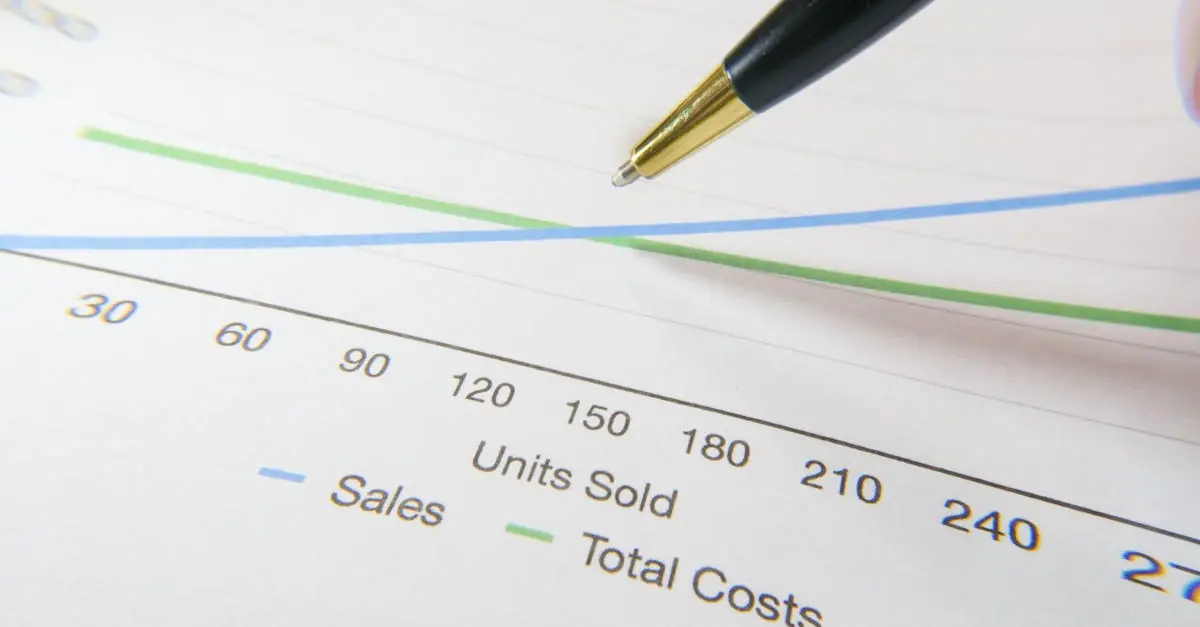Alaska, known for its stunning landscapes and majestic wildlife, also has a story to tell about its economy that’s just as captivating. As the Last Frontier navigates through shifting tides of economic trends, it’s not just about fishing and oil anymore. From the rise of tech startups in Anchorage to the booming tourism sector, Alaska’s economy is evolving faster than a moose on the run.
But don’t let the cold fool you; there’s some hot economic activity brewing. With a mix of traditional industries and innovative ventures, understanding these trends is crucial for anyone looking to invest, live, or simply stay informed about this unique state. So buckle up as we dive into the economic currents shaping Alaska’s future—because who knew the land of ice and snow could also be a hotbed of opportunity?
Table of Contents
ToggleOverview of Alaska Economic Trends
Alaska’s economy is adjusting to new realities, shifting from traditional sectors to innovative industries. The state’s reliance on oil and gas persists, but diversification is becoming increasingly evident. Growth in technology startups demonstrates this trend, with companies leveraging Alaska’s unique resources and talent.
Tourism has also surged, playing a pivotal role in the state’s financial landscape. The natural beauty and cultural heritage attract millions annually, contributing significantly to employment and revenue. In 2022, Alaska welcomed over 1.5 million visitors, showcasing the sector’s resilience.
Fishing remains a cornerstone of the economy, valued not only for its historical significance but also for its ongoing contributions. The commercial fishing industry contributes approximately $1.5 billion to the state’s economy each year. Sustainable practices ensure continued viability in a shifting market.
Emerging sectors like renewable energy gain traction, aligning with global sustainability efforts. Investments in wind and solar technologies position Alaska as a player in the green energy movement. In 2023, renewable energy projects accounted for a growing share of job creation.
Data indicates a shift in economic activity towards urban areas, particularly Anchorage and Fairbanks. Urban centers not only offer diverse job opportunities but also foster entrepreneurial ventures. Communities are increasingly vital in this evolving economic landscape, driving innovation and collaboration.
Overall, Alaska’s economy reflects a robust adaptation to change. Traditional sectors remain essential, but emerging industries are paving the way for a dynamic future. Understanding these trends proves crucial for stakeholders looking to engage with the state’s evolving opportunities.
Key Industries Driving Growth
Alaska’s economy thrives on several key industries, each contributing to growth in unique ways.
Oil and Gas Sector
The oil and gas sector significantly influences Alaska’s economy, generating substantial revenue and job opportunities. Approximately 80% of the state’s unrestricted funds come from oil tax revenue, underlining its importance. Exploration and production activities continue, with North Slope oil fields holding vast untapped potential. Major players in this industry include ConocoPhillips and ExxonMobil, investing in technology and sustainable practices to enhance efficiency. During 2022, oil production levels averaged about 500,000 barrels per day, showcasing resilience in a changing market.
Fishing and Seafood Industry
Fishing and seafood play a critical role in Alaska’s economic framework, contributing around $1.5 billion annually. The state remains one of the largest sustainable fisheries in the U.S., with vital species like salmon, crab, and pollock drawing attention. Over 58,000 commercial fishing permits highlight participation, supporting coastal communities. Sustainable practices ensure the viability of these resources for future generations. Seafood exports reached approximately 1.5 billion pounds in 2021, showcasing the global demand for Alaska’s products.
Tourism in Alaska
Tourism has emerged as a dynamic driver of economic growth in Alaska, attracting over 1.5 million visitors in 2022. The state’s breathtaking landscapes and vibrant culture offer unique experiences that extend beyond traditional outdoor activities. Cruise ships significantly contribute to tourism revenue, while adventure tourism continues to gain traction. Employment opportunities in the tourism sector have increased, reflecting the industry’s impact on local economies. Given these trends, investing in tourism-related ventures holds promise for both residents and investors alike.
Economic Challenges Facing Alaska
Alaska faces several economic challenges that affect its growth and stability. These obstacles require strategic management to navigate effectively.
Infrastructure Issues
Infrastructure development remains a significant challenge for Alaska’s economy. Many rural areas lack adequate transportation, impacting access to goods and services. In urban centers, aging facilities struggle to meet growing demands. The state’s harsh climate complicates construction and maintenance, leading to increased costs. Poor infrastructure can hinder business expansion and deter potential investments.
Cost of Living
The cost of living in Alaska ranks among the highest in the United States. Residents experience elevated prices due to remote location and transportation costs. Housing expenses, in particular, burden many households, with some areas reporting costs up to 50% higher than the national average. Essentials such as food and fuel also carry premium price tags. High living costs can discourage migration and strain the local workforce, impacting overall economic growth.
Government Policies Impacting the Economy
Government policies shape Alaska’s economic landscape significantly. Institutions prioritize maintaining a balanced state budget while managing revenues from various sectors.
State Budget and Revenues
The state budget relies heavily on revenue from the oil and gas industry, which constitutes about 80% of unrestricted funds. In 2022, oil production averaged 500,000 barrels per day, generating substantial income for state operations. Income taxes are absent in Alaska, adding to the attraction for residents and businesses alike. With recent fluctuations in oil prices, officials navigate challenges to ensure fiscal stability. Budget initiatives focus on funding critical infrastructure and services across urban and rural areas. This balance aims to foster economic growth while addressing essential statewide needs.
Economic Diversification Efforts
Efforts toward economic diversification are gaining momentum in Alaska. Policymakers promote sectors like technology and tourism to reduce reliance on oil revenues. In 2022, tourism attracted over 1.5 million visitors, highlighting its significance as a growth driver. Programs support startups and innovation hubs to cultivate a thriving tech environment. Fishery sustainability practices continue to strengthen the seafood sector, enabling it to contribute approximately $1.5 billion annually. Meanwhile, urban centers like Anchorage and Fairbanks emerge as focal points for new businesses and job opportunities. These strategic initiatives aim to create a more resilient economy that can withstand market fluctuations.
Future Outlook for Alaska’s Economy
Alaska’s economic future hinges on several key factors that shape growth trajectories. Oil and gas will continue to play a critical role, with substantial revenue generation maintaining fiscal stability. Recent investments from major companies, such as ConocoPhillips and ExxonMobil, focus on enhancing efficiency and sustainability.
Emerging sectors are equally vital. Tourism has seen impressive growth, attracting over 1.5 million visitors in 2022. The influx of tourists has spurred job creation, especially in hospitality and adventure tourism. Job opportunities in urban centers like Anchorage and Fairbanks are on the rise, driven by new entrepreneurial ventures.
Challenges persist alongside growth opportunities. Infrastructure development remains a vital concern, especially in rural regions where transportation limitations affect accessibility. In urban areas, aging facilities struggle to accommodate increasing demands. Moreover, high living costs contribute to workforce strain, making it difficult to attract new residents.
Government policies will impact future economic stability. A balanced state budget remains essential, particularly as oil revenues account for about 80% of unrestricted funds. Policymakers are promoting diversification strategies aimed at reducing dependence on oil and enhancing economic resilience.
Innovative programs supporting technology startups are expected to cultivate a vibrant tech sector. Sustainable fishing practices will also play a crucial role in ensuring the seafood industry thrives. Alaskan seafood exports amounted to approximately 1.5 billion pounds in 2021, reinforcing the importance of sustainable practices.
Investors and stakeholders should monitor these trends closely. Understanding the interplay of traditional sectors and emerging industries can reveal significant opportunities in Alaska’s evolving economic landscape.
Alaska’s economy is navigating a transformative period marked by diversification and innovation. Traditional sectors like oil and fishing continue to provide a strong foundation while new industries such as technology and tourism are emerging as vital contributors. This blend of old and new presents unique opportunities for investors and residents alike.
As the state works to overcome challenges like infrastructure development and high living costs, the commitment to sustainable practices and economic resilience will be crucial. By fostering a dynamic environment that embraces change, Alaska is poised to thrive in the years ahead. Understanding these trends will be essential for anyone looking to engage with Alaska’s evolving economic landscape.





